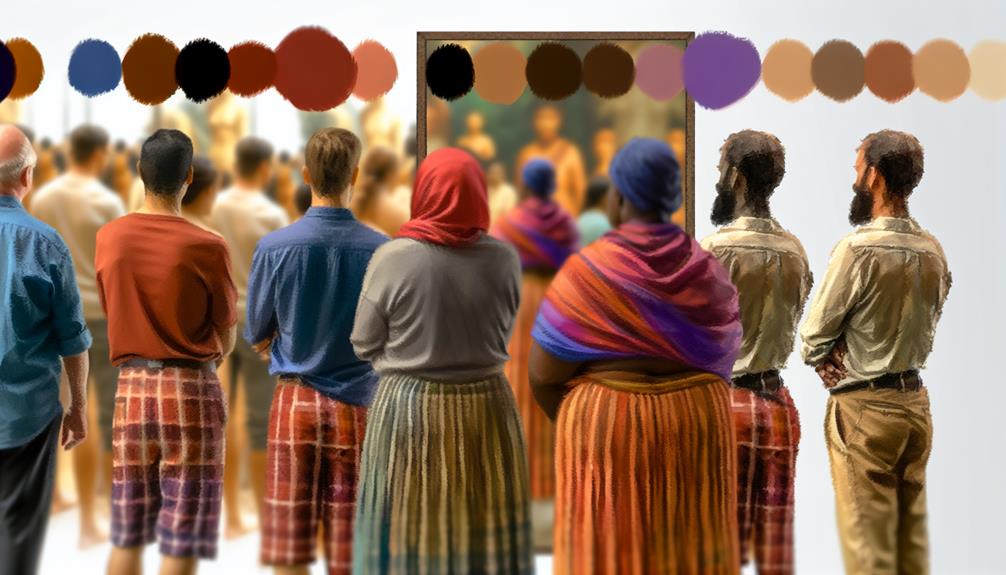Hip dips are natural indentations located near the hip bone, largely influenced by genetics, body structure, and individual fat distribution. Common in people of all body types, they often lead to misunderstandings about body image. To address hip dips, individuals can engage in targeted exercises like squats and lunges to strengthen glute muscles. Additionally, choosing flattering clothing, such as high-waisted bottoms and structured fabrics, can enhance one's silhouette. Embracing these unique features encourages self-acceptance and fosters a positive body image, which is paramount in today's society. There's much more to discover about embracing your body and enhancing confidence.
Key Takeaways
- Hip dips are natural indentations near the hip bone, influenced by genetics, body composition, and skeletal structure.
- Targeted exercises like squats, lunges, and glute bridges can help improve muscle development and reduce the prominence of hip dips.
- Balanced nutrition with proteins, healthy fats, and complex carbs supports muscle growth and overall fitness goals.
- Fashion choices, like high-waisted bottoms and structured materials, can enhance silhouette and boost confidence in body shape.
- Embracing body positivity and self-acceptance is crucial for fostering a healthy relationship with hip dips and body diversity.
Understanding Hip Dips

Hip dips, often referred to as "violin hips," are naturally occurring indentations found on the sides of the body, specifically where the hip bone meets the thigh. These features can vary in prominence and are influenced by genetic factors, body composition, and overall skeletal structure. Unfortunately, hip dip misconceptions often lead to negative body image and feelings of inadequacy, particularly in a society that often promotes unrealistic beauty standards.
Societal standards can create pressure to conform to a narrow definition of beauty, which frequently excludes natural body variations like hip dips. This can lead individuals to feel isolated or unaccepted if they don't fit the mold. It is crucial to recognize that hip dips are a normal anatomical feature, not a flaw to be fixed. Embracing our unique bodies fosters a sense of belonging and acceptance within ourselves and the larger community.
The Anatomy of Hip Dips
Understanding the anatomy of hip dips involves examining how they form, influenced by genetic factors and the distribution of muscle and fat in the body. Many individuals may also find that lifestyle choices, such as exercise and diet, can impact the appearance of hip dips. These indentations, often seen between the hips and thighs, are a natural variation in body shape that many individuals experience. By exploring these aspects, we can better appreciate the diversity of our bodies and address any concerns related to hip dips with informed empathy. Additionally, it's important to recognize that achieving a healthy work-life balance can help promote overall well-being, similar to how remote customer service jobs can offer flexible work options.
Understanding Hip Dip Formation
Many individuals notice the presence of hip dips, which are natural indentations located just below the hip bone. These formations can often lead to misunderstandings and misconceptions, as hip dip myths pervade popular culture. Many people perceive hip dips as a flaw or an undesirable trait, which can foster feelings of insecurity. However, it is crucial to recognize that hip dips are a normal anatomical feature and vary among individuals regardless of body type.
The perception of hip dips is influenced by societal beauty standards, which often favor certain silhouettes over others. Unfortunately, this can lead to undue pressure and a sense of exclusion for those who do not fit these narrow ideals. Embracing the uniqueness of our bodies, including hip dips, can cultivate a sense of belonging and self-acceptance.
Understanding that hip dips are simply a part of our anatomy allows for a healthier perspective. Rather than focusing on the negative connotations often associated with them, we can celebrate the diversity of body shapes. Ultimately, fostering a positive view of hip dips can contribute to a more inclusive narrative around body image, helping individuals feel more connected to their own bodies and to one another.
Genetic Factors Involved
Genetic factors play a significant role in the formation of hip dips, influencing their prominence and shape among individuals. These dips, often perceived as a unique aspect of body structure, can be traced back to hereditary traits passed down through generations. The skeletal shape, specifically the width of the pelvis and the distribution of muscle and fat, is largely determined by genetics.
Individuals may find that their family history reveals a pattern, where hip dips are a common feature among relatives. This connection to lineage can help foster a sense of belonging, as understanding one's body in the context of genetic heritage allows for greater acceptance.
Moreover, recognizing that hip dips are a natural variation in body structure can alleviate feelings of inadequacy. Rather than viewing them as flaws, individuals can embrace these characteristics as part of their unique identity. Ultimately, it is essential to remember that while genetics influence our physical appearance, they do not define our worth. Embracing our bodies, including hip dips, can lead to a more positive self-image and a deeper appreciation for the diversity of human form.
Muscle and Fat Distribution
At the core of hip dips lies the intricate interplay of muscle and fat distribution within the body. Understanding this anatomy is essential for both men and women seeking to address their concerns about hip dips. Muscle symmetry plays a pivotal role in shaping our silhouette, while fat redistribution can notably impact how our bodies appear.
Hip dips, or the inward curves just below the hip bone, often stem from natural variations in fat and muscle placement. Some individuals may find that their body naturally stores fat in areas that accentuate these dips, leading to an uneven appearance. This is particularly true for those who may have a higher percentage of body fat or less developed glute muscles, as a lack of muscle mass can exacerbate the visibility of hip dips.
Engaging in targeted strength training can help enhance muscle symmetry, promoting a more balanced look. Additionally, body positivity and acceptance are vital; understanding that hip dips are a common trait can foster a sense of belonging. Everyone's body is unique, and embracing these differences can lead to greater self-love and confidence.
Causes of Hip Dips

Understanding the causes of hip dips is essential for those seeking to address them effectively. Genetic factors play a significant role in determining body shape, while individual patterns of body fat distribution and muscle development imbalances can further contribute to the appearance of hip dips. Additionally, cultural influences and trends in aesthetics, similar to how P. Diddy's impact on fashion has shaped perceptions of beauty over time, can also affect how individuals view their body shape. By recognizing these influences, individuals can approach their fitness and aesthetic goals with a more informed perspective.
Genetic Factors Influence Shape
Many individuals may be surprised to learn that the shape of their hips, including the presence of hip dips, is greatly influenced by genetic factors. Genetic predisposition plays a fundamental role in determining our body silhouette, affecting everything from bone structure to fat distribution.
Hip dips, often characterized by an inward curve just below the hip bone, can be traced back to the skeletal structure inherited from our parents. The width of the pelvis, the positioning of the hip joint, and the overall shape of our bones contribute considerably to how our bodies appear. Consequently, some individuals may naturally exhibit more pronounced hip dips while others have a smoother, more continuous contour.
Understanding that these variations are rooted in genetics can foster a sense of acceptance and belonging among those who may feel self-conscious about their hip shape. It's crucial to recognize that hip dips are a natural part of many body types, and embracing our unique silhouettes is key to self-love. Ultimately, acknowledging the genetic influences on our bodies allows us to focus on health and well-being rather than conforming to societal standards.
Body Fat Distribution Patterns
Recognizing the impact of body fat distribution patterns is essential in understanding the appearance of hip dips. These natural indentations can be influenced by an individual's unique body shape and how fat is distributed across the hips and thighs. It is important to note that our bodies come in diverse forms, which often leads to variations in how we perceive and engage with societal standards and aesthetic ideals.
Many fitness myths suggest that achieving a specific body shape is attainable through extreme measures, undermining the concept of body diversity. This misinformation can negatively impact body confidence and health perceptions, making individuals feel inadequate or pressured to conform to unrealistic standards. Embracing self-acceptance is crucial; understanding that hip dips are a normal aspect of many body types can foster a healthier relationship with one's body.
Promoting awareness of body fat distribution patterns helps to cultivate a sense of belonging within communities where individuals celebrate their unique features. By shifting the narrative around body image, we can encourage a culture that values authenticity and supports body confidence, enhancing overall well-being and acceptance.
Muscle Development Imbalances
Muscle development imbalances can greatly contribute to the appearance of hip dips, highlighting the importance of balanced strength training in achieving desired body aesthetics. When specific muscle groups, particularly in the glutes and hips, are underdeveloped compared to others, it can create a noticeable indentation along the outer thighs. This lack of muscle symmetry may be influenced by factors such as genetics, lifestyle, and exercise routines that do not adequately target all areas of the lower body.
To address muscle imbalances, individuals should focus on a well-rounded strength training program that incorporates exercises targeting both the gluteus medius and minimus, as well as other muscle groups in the hips. Incorporating movements such as lateral band walks, hip thrusts, and squats can enhance muscle development and promote a more balanced physique.
It's essential to approach this journey with patience and self-compassion, recognizing that everyone's body is unique. By fostering a sense of belonging within fitness communities and sharing experiences, individuals can find support and motivation while aiming for muscle symmetry and improved body confidence.
Fitness Strategies to Address Hip Dips
A variety of effective fitness strategies can help individuals address hip dips, promoting a more balanced and contoured silhouette. Focusing on glute activation is essential, as strong glutes can help fill in the areas where hip dips are more pronounced. Incorporating targeted exercises such as squats, lunges, and glute bridges into your strength training routine can yield significant results, especially when combined with unlocking academic success through consistent study habits. Bodyweight workouts are also beneficial; they can be performed anywhere and require no equipment. Resistance bands can intensify these exercises, providing added tension that enhances muscle engagement. In addition, integrating cardio routines, such as cycling or dancing, can help improve overall fat distribution and encourage a healthier body composition.
Nutrition tips play a vital role in this journey as well. A balanced diet rich in proteins, healthy fats, and complex carbohydrates can support muscle growth and overall wellness. Furthermore, flexibility training and posture improvement exercises, like yoga or Pilates, can enhance body alignment and create a more aesthetically pleasing shape.
Fashion Tips for Hip Dips

While fitness strategies play a significant role in addressing hip dips, fashion choices can also enhance one's silhouette and boost confidence. By employing specific styling techniques, you can create outfit ideas that celebrate your unique shape. It's important to remember that personal style can be a reflection of individuality and values, similar to how brands express their stances on various issues, such as supporting Israel.
Start with fabric selection; opt for structured materials that provide support while allowing for movement. High-waisted bottoms can create a smooth line from the waist down, effectively aiding in silhouette enhancement. Layering options, such as long cardigans or structured blazers, can also draw attention away from the hip area.
Color coordination plays a vital role—darker shades on the lower half can create visual illusions, while brighter colors on top can draw the eye upward. Additionally, fit adjustments are essential; tailored pieces often provide the best silhouette.
Accessorizing wisely can further elevate your look. Consider pairing statement belts to define your waist, or using bold necklaces to draw attention to your upper body. With thoughtful fashion choices, you can embrace your body's natural curves and feel empowered in your style, fostering a sense of belonging in any setting.
Embracing Body Positivity
In today's society, embracing body positivity is crucial for fostering self-acceptance and confidence, particularly for individuals who may feel insecure about features like hip dips. This journey towards self-acceptance involves recognizing that every body is unique, and that societal standards of beauty are often unrealistic and limiting. Much like the importance of understanding personal health journeys, such as in Bruce Willis' health journey, we can learn to appreciate our bodies for their resilience and uniqueness.
A positive body image is critical to nurturing a healthy relationship with ourselves. Instead of fixating on perceived flaws, we can celebrate our individuality and the characteristics that make us who we are. Engaging in conversations about body diversity and inclusivity helps create a supportive environment where everyone feels valued.
Self-compassion plays a key role in this process. Acknowledging our feelings about our bodies, while also reminding ourselves of our worth beyond physical appearance, is essential. Surrounding ourselves with affirming influences, whether through media, friends, or communities, can bolster our self-acceptance journey.
Ultimately, embracing body positivity involves shifting our mindset and choosing to appreciate our bodies, hip dips included. By cultivating a positive body image, we empower ourselves and inspire others to do the same, fostering a culture of acceptance and belonging for all.
Frequently Asked Questions
Are Hip Dips Genetic or Can They Be Changed?
Hip dips are influenced by genetic predisposition, as they relate to bone structure and fat distribution. While it is challenging to completely alter one's natural body shape, embracing body positivity encourages acceptance of all body types, including those with hip dips. Individuals can focus on fitness and strength training to enhance their overall physique, but it is essential to foster a healthy mindset that appreciates diverse body forms, promoting inclusivity and belonging within the community.
Can Diet Affect the Appearance of Hip Dips?
Diet can indeed influence the appearance of hip dips through dietary adjustments that promote overall body composition and fat distribution. While genetics play a significant role in body shape, a balanced diet rich in nutrients can enhance body image and boost confidence. Focusing on whole foods, adequate protein, and healthy fats may help individuals feel more satisfied with their bodies, fostering a sense of belonging and acceptance within diverse communities.
Are There Specific Exercises to Target Hip Dips?
To address the concern of hip dips, specific hip dip exercises can be highly effective. Targeted workouts such as side lunges, glute bridges, and clamshells can strengthen the muscles around the hips, enhancing overall shape and reducing the appearance of hip dips. Incorporating these exercises into a regular fitness routine fosters a sense of belonging within a supportive community focused on body positivity and personal wellness. Embrace these movements to cultivate confidence and self-acceptance.
Do Hip Dips Affect Overall Health or Mobility?
Hip dips do not inherently affect overall health or mobility; however, their implications can lead to mobility concerns if individuals experience body image issues or psychological distress. Such feelings may discourage physical activity, potentially impacting overall fitness. It is crucial to foster an inclusive environment that embraces diverse body shapes, promoting positive body image and encouraging individuals to engage in physical activities that enhance mobility and overall well-being, regardless of their hip structure.
How Do Celebrities Feel About Their Hip Dips?
Celebrity insights reveal a diverse range of perspectives on hip dips, often reflecting broader trends in body positivity. Many celebrities embrace their natural shapes, using their platforms to promote acceptance and self-love. This advocacy fosters a sense of belonging among fans, encouraging individuals to appreciate their unique bodies. By challenging societal beauty standards, these public figures inspire others to celebrate their differences, ultimately contributing to a more inclusive dialogue around body image and self-acceptance.

